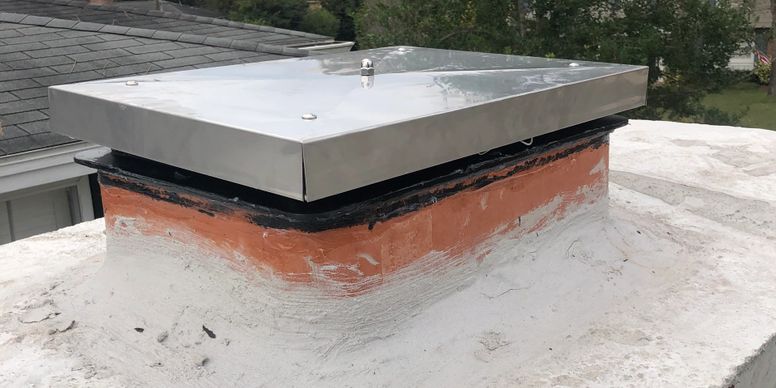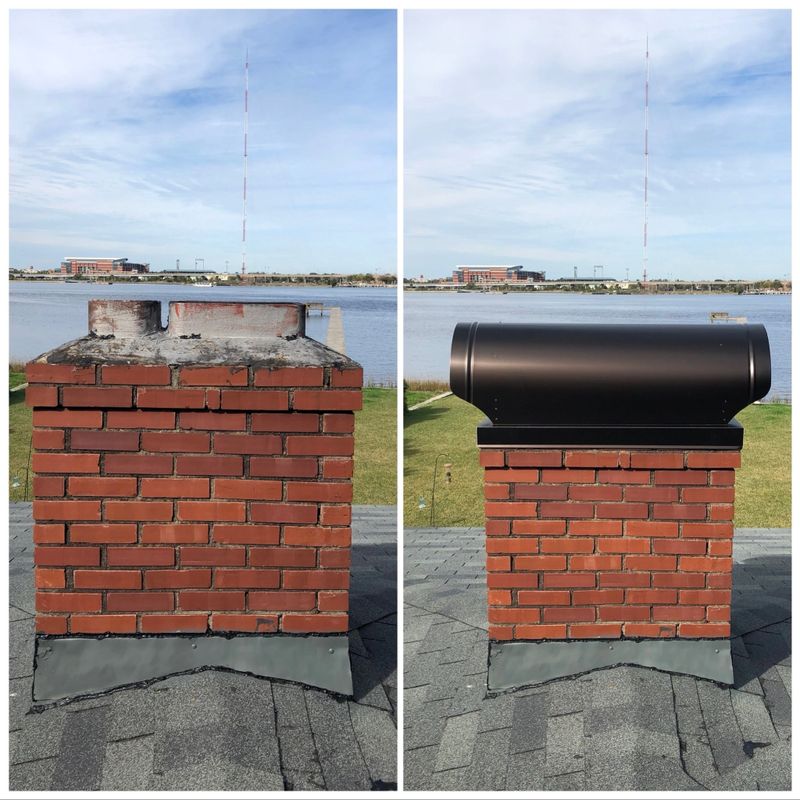Chimney Repairs
An inspection may identify the need for repairs. We offer repair services including cap and cover replacements, HeatShield chimney repair, top-mounted dampers, and other repairs as needed based on the outcome of your inspection.

Chase Covers
Chase cover replacement is recommended when the original cover deteriorates and can become vulnerable to water intrusion. Some warning signs include rust stains on the chimney chase below.Chase cover replacement is recommended when the original cover deteriorates and can become vulnerable to water intrusion. Some warning signs include rust stains on the chimney chase below.

Smoke Chamber Repair
Just above most all masonry fireplaces you will find the smoke chamber. When deteriorated or improperly constructed, fireplace performance and safety issues may occur. Just above most all masonry fireplaces you will find the smoke chamber. When deteriorated or improperly constructed, fireplace performance and safety issues may occur.
HeatShield Chimney Repair
Damaged chimney liner? HeatShield® can restore your chimney’s clay flue liner and save you the expense of rebuilding or relining with a stainless steel chimney liner.

Custom Fabrication

Chimney Restoration
From lightning strikes to flooding chimneys, we can find a solution that meets your needs.

Top Mounted Dampers
Many older Fireplaces were built without dampers. Installation of a top-mounted damper can be a great way to keep the AC in and the animals out.
Why It’s Essential
Like many things in your home, your chimney will require regular repair and maintenance. Cracks, liner damage, and just general wear and tear are some of the occasional problems that you will need to fix to keep your chimney in top working order. While some repairs you can do yourself, it is advisable to hire a professional as soon as possible before the crack or problem gets bigger.

Most home chimneys are what are known as masonry chimneys, in that they are typically built with a type of masonry or stone, such as brick, mortar, concrete or even some metals, like steel or cast iron. These types of chimneys might not be part of a more modern home design, but most people prefer the classic look and feel of a brick or stone chimney. These types of chimneys can last for a very long time. But like anything else, they also need the occasional maintenance or repair.
Cracks in the brick are one of the most common structural problems that will need to be repaired. Whether the bricks themselves break, or there’s a split in the mortar between the bricks, it is very important to quickly and correctly fix a crack. Smoke and other harmful particles can easily slip through cracks, whether into your living area or into the walls and roof of your home. If the cracks grow too big, a complete and costly demolition may be in order.
A common place for cracks is in the chimney’s crown, at the very top of the structure. Once the crown starts to crack, it can be very difficult to fix and could lead to the whole crown falling apart or becoming lopsided as it sits atop your chimney. The crown serves to keep rain, animals, and other hindrances from getting down into your chimney.
Water can cause a whole host of problems for chimneys that will need repair. One of the biggest concerns is water mixing with the creosote that has built up in your chimney. This mixture can become acidic and will speed up the deterioration of the brick and mortar of your chimney. This can also cause rust to build up on the metal parts inside the chimney, such as the damper.
A proper working chimney damper should open and close without any trouble. A damper should also seal tight. Rust or cracks in the damper can affect the heating of your house and become a costly problem for your monthly heating bills.

Water can also cause problems for the chimney liner. Many modern chimneys have a protective liner that is usually made from stainless steel, aluminum, terra cotta, or other fireproof materials. This liner keeps excess heat from filling your home, and significantly increases the structural integrity of your chimney. A cracked or damaged liner can increase the risk of a dangerous chimney fire.

The Chimney Safety Institute of America recommends that open masonry fireplaces should be swept at 1/8″ of sooty buildup, and sooner if there is any glaze present in the system. This is considered to be enough fuel buildup to cause a chimney fire capable of damaging the chimney or spreading to the home. Factory-built fireplaces should be swept when any appreciable buildup occurs. The logic is that the deposit is quite acidic and can shorten the life of the fireplace.
Schedule An Inspection
Call (904) 678-1790 Or Click the Link To the Right to Schedule Your Next Service Right Away








